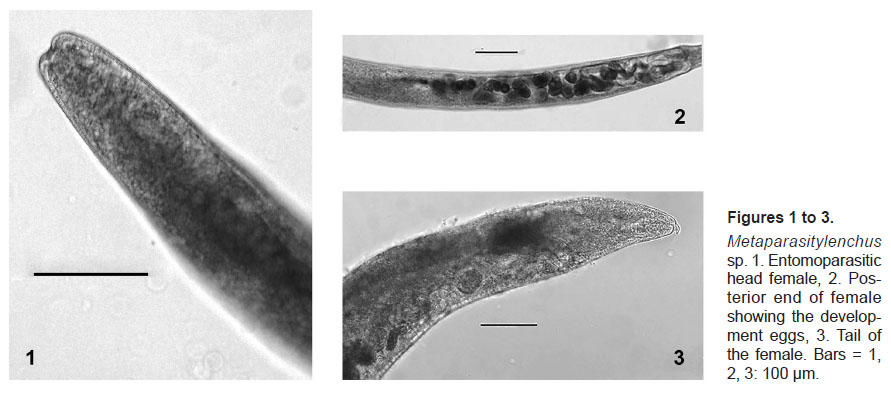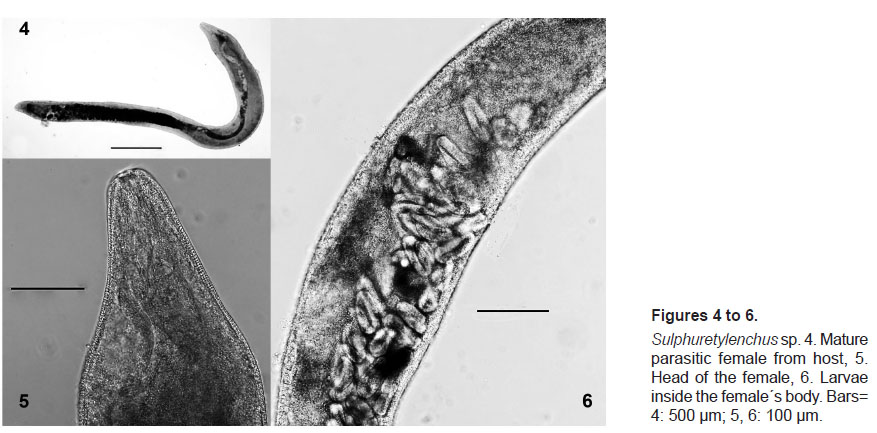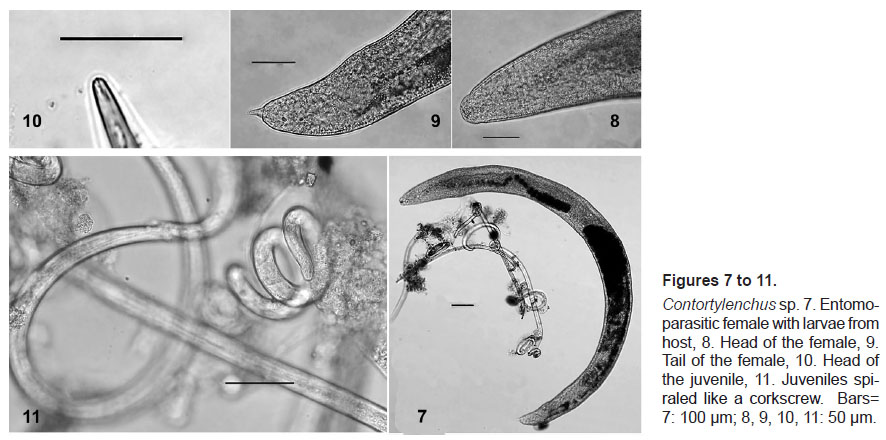Servicios Personalizados
Revista
Articulo
Indicadores
-
 Citado por SciELO
Citado por SciELO
Links relacionados
-
 Similares en
SciELO
Similares en
SciELO  uBio
uBio
Compartir
Revista Peruana de Biología
versión On-line ISSN 1727-9933
Rev. peru biol. vol.23 no.3 Lima set./dic. 2016
http://dx.doi.org/10.15381/rpb.v23i3.12870
10.15381/rpb.v23i3.12870
NOTA CIENTÍFICA
Tylenchids nematodes (Tylenchida) parasitizing field population of Harmonia axyridis, and Cycloneda sanguinea (Coleoptera, Coccinellidae) in Argentina
Nemátodos tylenchidos (Tylenchida) parasitando poblaciones de campo de Harmonia axyridis y Cycloneda sanguinea (Coleoptera, Coccinellidae) en Argentina
Nora B. Camino 1,5, Sandra E. González 3,5, Guillermo R. Reboredo 4,5, Matías N. Rosales 3,5 and Fernanda M. Zanca 2,5
1 Investigador CIC
2 Investigador CONICET
3 Personal de Apoyo CIC
4 CONICET
5 Centro de Estudio Parasitológicos y de Vectores, CEPAVE CCT La Plata CONICET, Facultad de Ciencias Naturales y Museo, UNLP.
Email Nora Camino: nemainst@cepave.edu.ar
Email Sandra González: san.gonzalez.san@gmail.com
Email Guillermo Reboredo: grreboredo@yahoo.com.ar
Email Matías Rosales: matur88@hotmail.com
Email Fernanda Zanca: fmzanca2002@yahoo.com
Abstract
For the first time in Argentina, we report that in Harmonia axyridis Pallas, 1773, and Cycloneda sanguinea (Linnaeus, 1763) (Coleoptera, Coccinellidae) parasitizing by nematodes which belong to the family of Allantonematidae (Nematoda, Tylenchida). The genera are Metaparasitylenchus Wachek, 1955 (Nickle, 1967), Sulphuretylenchus Rühm, 1956 (Nickle, 1967) and Contortylenchus Rühm, 1956. They will be described and photographied afterwards.
Keywords: Tylenchida; nematodes; parasites; Coccinellidae; Argentina.
Resumen
Se cita por primera vez para la Argentina nemátodos parásitos de Harmonia axyridis Pallas, 1773, y Cycloneda sanguinea (Linnaeus, 1763) (Coleoptera, Coccinellidae), estos nemátodos pertenecen a la familia de Allantonematidae (Nematoda, Tylenchida). Los géneros hallados son Metaparasitylenchus Wachek, 1955 (Nickle, 1967), Sulphuretylenchus Rühm, 1956 (Nickle, 1967) y Contortylenchus Rühm, 1956. Se describen y fotografían.
Palabras claves: Tylenchida; nematodos; parásitos; Coccinellidae; Argentina.
Introduction
Harmonia axyridis Pallas, 1773, the multicoloured Asian lady beetle (Koch 2003), and Cycloneda sanguinea (Linnaeus, 1763), the ladybugs (Bennett & Gordon 1991), are introduced as a biological control agent that are spreading rapidly throughout Argentina (Saini 2004). Despite the fact they are an effective biological control agent in agricultural and landscape environments, they have become a major nuisance to homeowners because of their habit of invading houses and buildings in large numbers while searching for protected sites to overwinter in the fall (mid-May to early August) and appearing again on warm days in September and October (Saini 2004). In addition, beetles may get in picnic food and drinks, "swarm" like bees and land on people (Brown 2011). Both species prey upon many species of injurious soft-bodied insects such as aphids, scales, and psyllids and it is thus considered beneficial for growers and agriculturalists. Ladybird is the name that has been used for more than six centuries in Europe for both coleopteran species. We find for the first time in Buenos Aires, Argentina, three genera of Tylenchida nematodes pathogenic; they are parasites of the body cavity of these invasive species of insects and they cause deaths.
Material and methods
Adult coccinelids insects were collected by hand from November to March 2015/2016 on two different plant species (kale: Brassica oleracea L.; thistle: Silybum marianum (L.) Gaertn, at two localities near Gran La Plata, Colonia Urquiza (34°96'72"S, 58°04’96"W), and Magdalena (35°06’65"S, 57°53’30"W) respectly, and they were put in individual plastic containers. In total, 195 H. axyridis Pallas, 1773, and 248 C. sanguinea (Linnaeus, 1763) (Coleoptera, Coccinellidae) were sampled and dissected. The coccinellids adults were dissected in Petri dishes filled with distilled water under a stereomicroscope. The nematodes were killed by placing them in distilled water at 60 °C for 2 min. They were removed with 50% TAF solution in water for 48 hours and then into pure TAF (Poinar 1975). All the specimens were used for photographing in Olympus BX51 microscope with Olympus DP71 camera.
Nematodes from infected ladybirds specimens were preserved in TAF pure in the Invertebrate Department, Museo de Ciencias Naturales, La Plata, Argentina (MLP), and in the Centro de Estudios Parasitológicos y Vectores (CEPAVE), Nematoda collection, La Plata, Argentina.
Results
Tylenchida Thorne, 1949, is an order of nematodes that includes plant-parasitic nematodes with economically importance, and it forms parasitize insect’s haemocoels which must be considered as biological control agents (Siddiqi 2000). The entomoparasitic nematodes belong to suborder Hexatylina Siddiqi, 1980, characterized by only being the gametogenetic female parasitic, and males rarely occur inside the host. Most of the entomoparasitic Tylenchida nematodes leave their hosts as juveniles or eggs to develop them in female and male in the outside environment, where they eat fungus. The fertilized female is the infectant stage and it penetrates a host´s larva, or pupa, or adult to establish itself in the haemocoel (Massey 1974).
The nematodes we have found belong to the superfamily Sphaerularioidea Lubbock, 1861 (Poinar 1975), having two types of generations: on the one hand, we have a free-living, fungus feeding, and the other hand, another one involving a heterosexual female parasitic in insect haemocoel, or free-living fungus feeding generation cycle absent or unknown (Nickle 1967). They don’t complete the generation cycle in insect host. It includes two families, Sphaerulariidae which the entomoparasitic female everts the uterus that often hipertrophies it and leads an independent life, and Allantonematidae which entomoparasitic female does not evert uterus, and from this family come our nematodes (Siddiqi 2000). The tylenchids nematodes we found are adult parasitic female (with or without juveniles) in body cavity of insects; they belong to the family Allantonematidae.
Metaparasitylenchus Wachek, 1955 [Nickle, 1967]
We only found an entomoparasitic female in host; it is characterized by the body obese, cylindroid, slightly arcuate, with slight mobility, and white with yellow-brown metabolic deposits. Cephalic region and tail deformed by body expansion (Fig. 1). The cuticle may coarsely annulated and wrinkled, but body surface not wavy. The stylet knobbed, usually sunken in body. The uterus is enormous, filling most of the body cavity (Fig. 2). The ovary coiled in anterior region. The tail end conoid-rounded, with a peg-like projection (Fig. 3). Generally ovoviviparous. No male or complete generative cycle in host. (Laumond & Hervé Mauléon 1982, Poinar et al. 2004, Siddiqi 2000).
Host: H. axyridis, locality: Magdalena, plant: thistle.
Sulphuretylenchus Rühm, 1956 [Nickle 1967]
We found entomoparasitic female in the host. It has the body obese, elongate-tuboid, with rounded ends, the surface usually wavy with constrictions and swollen areas at times due to accumulation of eggs and juveniles (Fig. 4). The colour of the body is sulphur yellow-brown to dark brown. The stylet sunken into body, conus usually asymmetrical and basal knobs flattened laterally (Fig. 5). The esophagus and intestine degenerate. Vulva indistinct; uterus large, with numerous eggs and sometimes early-stage juveniles (Fig. 6). The ovary is reflexed from one to several times, often reaching esophagus region. Ovoviviparous. The male is not found in host´s body (Nickle 1967, Massey 1974, Siddiqi 2000).
Host: C. sanguinea, locality: Magdalena, plant: thistle.
Contortylenchus Rühm, 1956
The entomoparasitic female with juveniles larva was found in the host (Fig. 7). The female has a long body, elongate cylindroid, partially obese, homomorphic, dorsally arcuate, yellow-brown. The cuticle is smooth, thick and firm, maintaining cylindroid shape of the body. The cephalic region is conoid-rounded (Fig. 8), not deformed or overgrown by body expansion, which includes the stylet moderately strong with basal knobs. Vulva strongly cleft, at about 96%. Vagina short with thick walls. Uterus long, with several synchronous eggs. Ovary reflexed one time. Tail end conoid and obtuse (Fig. 9). No males in host. Newly hatched juveniles with a small slender stylet (Fig. 10), without basal knobs and the body presenting a way of spiraling like a corkscrew (Fig. 11) (MacGuidwin et al. 1980, Siddiqi 2000, Thong & Webster 1972).
Host: H. axyridis, locality: Colonia Urquiza, plant: kale.
Discussion
To the current date there are no reports of presence of Tylenchida in our country, we consider these three genera the first to be cited to Argentina. We observed that Tylenchids nematodes are well represented and diversified in a small number of host species and geographic areas restricted. The genus Metaparasitylenchus is found very closed to Parasitylenchus Micoletzky, 1922, which has a stylet present, gonad with short flexure, uterus with few eggs and it has a small parasitic male (Harding et al. 2011, Poinar & Steenberg 2012, Siddiqi 2000). The other genus Sulphuretylenchus is characterized by the typical surface with constrictions and swollen areas (Nickle 1967, Siddiqi 2000), and Contortylenchus can be identify by the type of ovary that is unique in the genus. It is usually reflexed one or more times, the oocytes are arranged in two or more rows, the parasitic female is strongly dorsally curved and our species present the juveniles spiraled like a corkscrew (MacGuidwin et al. 1980, Siddiqi 2000, Thong & Webster 1972).
Further studies on the life-cycle of these nematodes and their interactions with ladybirds host are in progress supported by this future molecular study.
Acknowledgements
We would like to thank Lic. Luis Giambelluca for photograpied the material. Many thanks also to Manuela Reboredo to revision of the language and two anonymous reviewers for the constructive comments on the manuscript.
Literature cited
Bennett F.D., R.D. Gordon. 1991. New Florida ladybeetle. Florida Entomologist. 74: 598-599. [ Links ]
Brown M.W. 2011. Importance of early arrival of adult Harmonia axyridis for control of Aphids spiraecola on apple. BioControl. 56: 65-69. DOI: http://dx.doi.org/10.1007/s10526-010-9311-0 [ Links ]
Harding S., G.O. JR Poinar, D.V. Dimitrova & T. Steenberg. 2011. Parasitylenchus sp. (Tylenchomorpha: Allantonematidae) parasitizing field populations of Harmonia axyridis (Coleoptera: Coccinellidae). European Journal of Entomology. 108: 487–488. DOI: http://dx.doi.org/10.14411/eje.2011.062 [ Links ]
Koch R.L. 2003. The multicolored Asian lady beetle, Harmonia axyridis: A review of its biology, uses in biological control, and non-target impacts. Journal of Insect Science. 3: 32. [ Links ]
Laumond C. & H. Hervé Mauléon. 1982. Metaparasitylenchus guadelouyensis n. sp. (Tylenchida, Allantonernatidae) Parasite d‘Hexucolus guyunensis (Coleoptera, Scolytidae) en Guadeloupe. Revue de Nematologie. 5: 65-69.
MacGuidwin A.E., G.C. Jr. Smart & G.E. Allen. 1980. Redescription and life story of Contortylenchus brevicomi a parasite of the southern pine beetle Dendroctonus frontalis. Journal of Nematology. 12: 207-212. [ Links ]
Massey C. 1974. Biology and taxonomy of nematodes parasites and associates of bark beetles in the United States. U.S. Department of Agriculture Forest Service, Agriculture handbook 446. [ Links ]
Nickle W.R. 1967. On the classification of the insect parasitic nematodes of the Sphaerulariidae Lubbock, 1861 (tylenchoidea: Nematoda). Procceding of the Helminthological Society of Washington. 34: 72-94. [ Links ]
Poinar G.O. Jr. 1975. Entomogenous nematodes, a manual and host list of insect-nematodes associations. Leiden, The Netherlands, E.J. Brill. [ Links ]
Poinar G.O. Jr. & T. Steenberg. 2012. Parasitylenchus bifurcatus n. sp. (Tylenchida: Allantonematidae) parasitizing Harmonia axyridis (Coleoptera: Coccinellidae). Parasites & Vectors. 5: 218-225. Doi: http://dx.doi.org/10.1186/1756-3305-5-218 [ Links ]
Poinar G.O. Jr., F.E. Vega, A. Castillo, I.E. Chavez & F. Infante. 2004. Metaparasitylenchus hypothenemi n. sp. (Nematoda: Allantonematidae), a Parasite of the Coffee Berry Borer, Hypothenemus hampei (Curculionidae: Scolytinae). The Journal of Parasitology. 90: 1106-1110. [ Links ]
Saini E.D. 2004. Presencia de Harmonia axyridis (Pallas) (Coleoptera: Coccinelidae) en la Provincia de Buenos Aires. Aspectos biológicos y morfológicos. Ria, Inta, Argentina. 33: 151-160. [ Links ]
Siddiqi M.R. 2000. Tylenchida. Parasites of plants and insects. 2nd. Edition. CABI Publishing. London Uk. [ Links ]
Thong C.H.S. & J.M. Webster. 1972. A redescription of the bark beetle nematode Contortylenchus brevicomi synonym Contortylenchus barberus (Nematoda: Sphaerulariidae). Journal of Nematology. 4: 213-216. [ Links ]
Información sobre los autores:
NBC, SEG, GRR, MNR & FMZ conceived the work, collected and analyzed the samples, contributed with reagents/materials/analysis tools, and wrote the manuscript.
The authors have declared that no competing interests exist.
Presentado: 10/05/2016
Aceptado: 10/10/2016
Publicado online: 20/12/2016
















